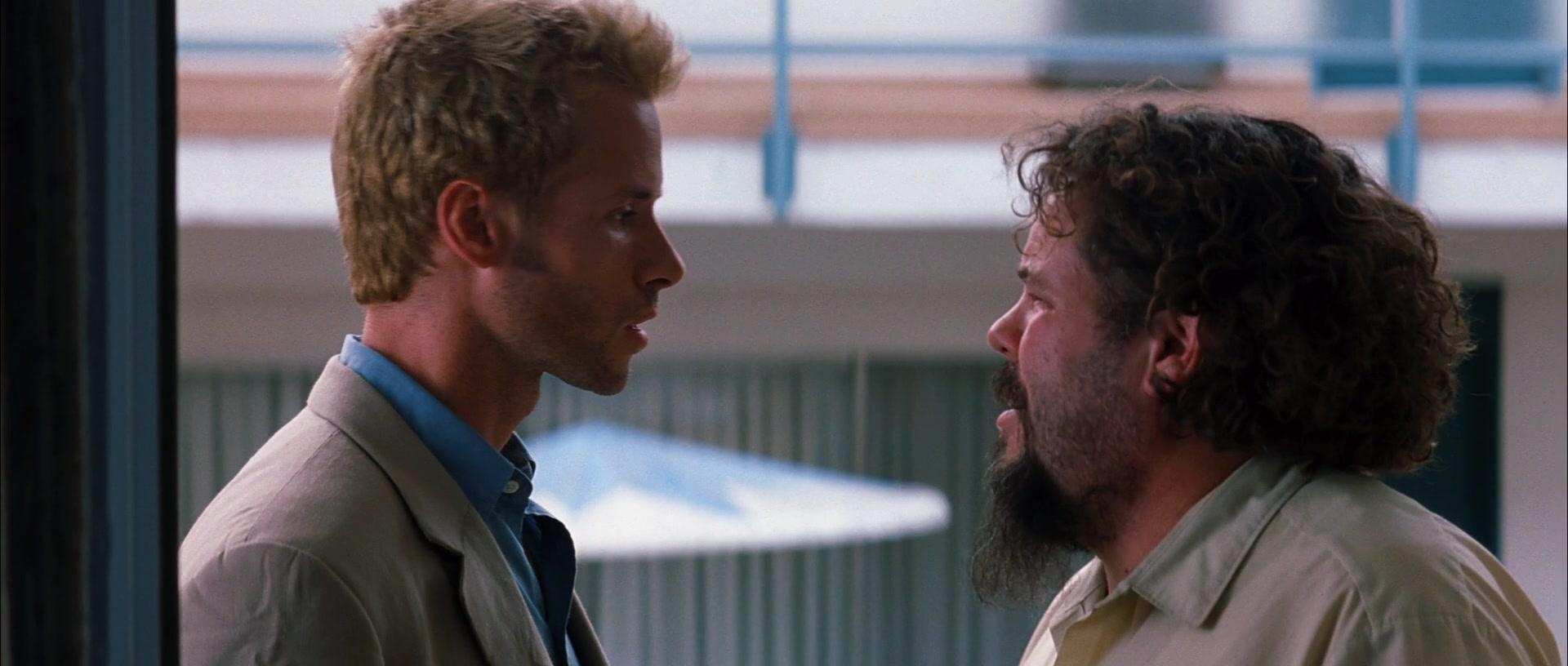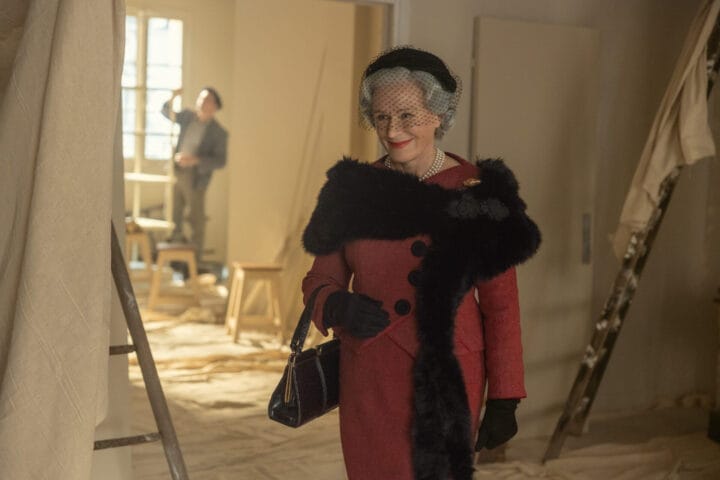I. Introduction: Unpacking the Puzzle Box
Christopher Nolan’s Memento (2000) stands as a landmark achievement in contemporary cinema, a meticulously crafted neo-noir psychological thriller that announced the arrival of a major directorial talent. Released to critical acclaim and achieving significant commercial success despite its modest budget, the film follows Leonard Shelby (Guy Pearce), a former insurance investigator grappling with anterograde amnesia—a condition rendering him incapable of forming new memories. His existence is a fragmented mosaic, navigated through an elaborate system of Polaroid photographs, handwritten notes, and intricate tattoos; mnemonic devices employed in his relentless quest to identify and exact revenge upon the man he believes raped and murdered his wife.
Memento quickly transcended its genre trappings, earning recognition not only for its gripping narrative but primarily for its revolutionary approach to storytelling. Nolan, working from a screenplay based on his brother Jonathan Nolan’s short story “Memento Mori,” constructed a narrative architecture that mirrors the protagonist’s cognitive state, challenging audiences and cementing the film’s place as a significant work. Its exploration of memory, identity, grief, and the subjective nature of truth resonated deeply, leading to Academy Award nominations for Best Original Screenplay and Best Film Editing, and its eventual selection for preservation in the United States National Film Registry by the Library of Congress in 2017, deeming it “culturally, historically, or aesthetically significant”. The film’s genesis, rooted in Jonathan Nolan’s short story, marks an early instance of the creative synergy between the Nolan brothers, foreshadowing recurring thematic concerns—particularly the manipulation of time, the fragility of memory, and the construction of identity—that would become hallmarks of Christopher Nolan’s subsequent filmography. This familial origin suggests that the film’s complex explorations may stem from deeply ingrained intellectual and narrative interests shared between the siblings.
The production brought together a team whose contributions were integral to realizing Nolan’s complex vision. Guy Pearce delivered a career-defining performance as the amnesiac Leonard, supported by Carrie-Anne Moss as the enigmatic Natalie and Joe Pantoliano as the potentially duplicitous Teddy. Behind the camera, Wally Pfister’s cinematography established the film’s distinct visual identity, Dody Dorn’s editing masterfully navigated the complex timelines, and David Julyan’s score underscored the pervasive mood of uncertainty and loss.

II. Deconstructing Time: The Anachronic Narrative Architecture
The most immediately striking and widely discussed aspect of Memento is its innovative narrative structure, a deliberate and intricate design that eschews conventional linear progression. Nolan employs what can be termed a ‘dual narrative structure’ or ‘anachronic storytelling’, weaving together two distinct timelines that move in opposing directions, ultimately converging to form a cohesive, albeit challenging, whole.
The primary narrative thread unfolds in color sequences presented in reverse chronological order. The film opens near the story’s chronological end – Leonard executing Teddy – and subsequent color scenes progressively reveal the events that led to this climax, moving backward step-by-step. Each color segment depicts a continuous block of action, typically ending just before the point where the preceding color segment (in the film’s presentation order) began. This reverse sequencing is the film’s core mechanism for simulating Leonard’s anterograde amnesia for the viewer. Like Leonard, the audience enters each color scene lacking the immediate context of what transpired just moments before, experiencing a similar disorientation and forcing an active engagement in piecing together the causal chain in reverse.
Interspersed with these reverse-chronological color sequences are segments filmed in black-and-white, which are presented in conventional chronological order. These scenes primarily depict Leonard in a motel room, engaged in telephone conversations where he explains his condition, his methods, and recounts the story of Sammy Jankis, another amnesiac he investigated in his former career. These black-and-white sequences provide exposition and a semblance of linear progression, anchoring the viewer temporarily before plunging back into the disorienting reverse flow of the color timeline.
This ‘fragmented narrative’ transforms the act of watching into an intellectual exercise, a puzzle demanding constant attention and reconstruction. Instead of traditional suspense about what will happen, Memento generates curiosity about what just happened and why. The narrative structure compels the audience to adopt Leonard’s investigative mindset, sifting through clues and re-evaluating information as the timeline unfolds backward.
The two timelines eventually meet at a crucial convergence point. This transition is masterfully handled during a scene where Leonard takes a Polaroid photograph of Jimmy Grantz’s body; as the photograph develops, the image transitions from black-and-white to color, seamlessly linking the end of the chronological black-and-white sequence with the beginning (chronologically) of the reverse-ordered color sequence. This moment is pivotal, not only structurally linking the two threads but also triggering Leonard’s (and the audience’s) re-evaluation of events upon hearing Jimmy whisper “Sammy”.
Beyond merely mimicking Leonard’s cognitive state, this complex architecture serves as a profound commentary on the nature of narrative itself. By disrupting the expected linear flow, Nolan foregrounds the artificiality of storytelling conventions. The audience is forced to confront how meaning is constructed through sequence and context, and how the denial of conventional chronology impacts understanding and emotional response. The film implicitly questions the viewer’s reliance on linear narratives for achieving a sense of truth or closure, suggesting that reality, like Leonard’s experience, might be inherently fragmented and open to interpretation.
Furthermore, the interplay between the black-and-white and color sequences initially suggests a dichotomy: the black-and-white representing a more objective, factual past (exposition, chronological order), while the color represents the subjective, chaotic present (reverse order, Leonard’s direct experience). However, the film cleverly subverts this expectation. The revelations surrounding the Sammy Jankis story—told predominantly in the “objective” black-and-white timeline but ultimately revealed by Teddy to be a distorted version of Leonard’s own past—retroactively destabilize the perceived reliability of the black-and-white sequences. This blurring demonstrates that Leonard’s unreliable perspective potentially taints all facets of the narrative presented, suggesting that the distinction between objective truth and subjective experience is porous, perhaps even illusory, within the framework of his consciousness and the film’s structure.
III. The Visual Language of Memory: Cinematography and Mise-en-Scène
The translation of Memento‘s intricate narrative and thematic concerns into a compelling visual experience owes much to the skillful work of cinematographer Wally Pfister. Pfister, in close collaboration with Nolan, developed a distinct visual strategy that not only differentiates the film’s dual timelines but also deepens the audience’s immersion into Leonard’s fractured world.
A fundamental aspect of the film’s visual design is the stark contrast between the color and black-and-white sequences. The black-and-white segments adopt the aesthetic conventions of classic film noir, characterized by high-contrast lighting (chiaroscuro) that sculpts faces and environments in sharp relief and deep shadow. This starkness, combined with often more static or controlled camera work, lends these scenes an air of clinical detachment or perceived objectivity, grounding Leonard’s expositional monologues and the Sammy Jankis flashbacks in a visually distinct reality.
Conversely, the color sequences, representing Leonard’s immediate, memory-deficient present, employ a different visual approach. While the lighting is generally softer and more naturalistic than the high-contrast noir of the black-and-white scenes, it is often filtered through a cool, blue-toned palette. This pervasive blueness contributes to a nocturnal, melancholic mood, even in daylight scenes, subtly reinforcing Leonard’s disorientation and the somber undertones of his quest. The color palette within these sequences is often muted, reflecting Leonard’s volatile emotional state, with occasional warmer hues appearing in brief flashes of memory associated with his wife, evoking nostalgia and loss. Pfister utilizes handheld camera work during moments of heightened confusion or panic within the color scenes, mirroring Leonard’s instability and enhancing the subjective experience for the viewer.
The film’s mise-en-scène—the arrangement of everything within the frame—is meticulously employed to reinforce narrative and theme. The settings are predominantly anonymous, transient spaces typical of the neo-noir genre: nondescript motel rooms, dimly lit bars, desolate warehouses, and vacant lots in an unnamed district of Los Angeles. These locations mirror Leonard’s internal state of displacement and the moral ambiguity of the world he inhabits. Props are imbued with immense significance, functioning as crucial narrative devices. Leonard’s Polaroid photos, handwritten notes, and tattoos are not just plot points but physical manifestations of his externalized memory—tangible ‘mementos’ that guide his actions and construct his reality, yet are vulnerable to manipulation and misinterpretation. His rumpled suits or borrowed clothes further signify his transient and often compromised state.
Compositional choices further enhance the film’s psychological depth. Leonard is frequently framed centrally but isolated, emphasizing his loneliness, or pushed to the edge of the frame during confrontations to signify his loss of control. Pfister employs shallow depth of field to draw focus to crucial details like the tattoos or Polaroids, immersing the viewer in Leonard’s obsessive focus. The recurrent motif of mirrors and reflective surfaces visually symbolizes Leonard’s fragmented identity and the theme of self-perception.
The camera consistently aligns the audience with Leonard’s subjective viewpoint. Over-the-shoulder shots and point-of-view perspectives are frequently used, particularly in the color sequences, forcing the viewer to experience the world through Leonard’s limited and disoriented perception. This subjective camera work is instrumental in creating empathy and understanding for his condition, even as his reliability as a narrator is questioned.
Ultimately, the visual strategy of Memento cleverly manipulates conventional cinematic language. The initial contrast between the stark “objectivity” of black-and-white and the subjective haze of color establishes a visual hierarchy that the narrative proceeds to dismantle. As the film reveals the potential unreliability permeating even the chronologically presented past (particularly the Sammy Jankis narrative), the visual cues themselves become suspect. This deconstruction reinforces the film’s core themes: that perception is subjective, memory is reconstructive, and visual evidence, like memory itself, is always open to interpretation and manipulation.
IV. Assembling Reality: Dody Dorn’s Oscar-Nominated Editing
The intricate temporal tapestry of Memento is woven together through the masterful editing of Dody Dorn, whose work was central to the film’s unique impact and earned her an Academy Award nomination for Best Film Editing. Dorn’s contribution was further recognized when the Motion Picture Editors Guild ranked Memento as the 14th Best Edited Film of All Time in 2012. Her task was formidable: to translate Nolan’s complex, blueprint-like script into a coherent yet deliberately disorienting cinematic experience.
Dorn’s primary achievement lies in the structuring of the film’s non-linearity. She meticulously assembled the color sequences in reverse chronological order, ensuring each segment flowed backward into the preceding one, while seamlessly intercutting these with the forward-moving black-and-white timeline. This complex interweaving, often referred to as cross-cutting or parallel editing, is not merely structural but thematic, constantly juxtaposing Leonard’s immediate, fragmented experience with the seemingly more stable, expository past.
Crucially, Dorn balances this radical discontinuity with conventional continuity editing techniques within individual scenes. Techniques like match-on-action (cutting between shots during a continuous movement) and shot-reverse shot (alternating shots of characters in conversation) are employed during dramatic moments. This adherence to continuity within sequences provides the audience with moments of narrative stability and clarity, preventing total confusion and anchoring the film’s more realistic aspects. However, the editing frequently disrupts this stability by cutting away at key moments or abruptly transitioning between timelines, sometimes mid-action (as when Leonard suddenly “comes to” during a chase), mirroring the jarring nature of Leonard’s memory resets. Jump cuts are also utilized to create a sense of fragmentation and unease.
To help the audience navigate the reverse chronology of the color sequences, Dorn employs the technique of overlapping action. Each color scene typically begins with a brief repetition of the action that concluded the previous color scene shown in the film (which chronologically occurred later). This overlap acts as a crucial orienting device, confirming the backward progression and allowing the viewer to establish temporal links between the fragmented segments.
The transition point where the black-and-white timeline bleeds into the color timeline is a moment of particular editorial finesse. Occurring as Leonard watches a Polaroid of the newly deceased Jimmy Grantz develop, the gradual emergence of color in the photograph visually mirrors the shift between the two narrative modes and timelines, elegantly unifying the structure at a key moment of revelation.
The overall effect of Dorn’s editing is to place the viewer directly into Leonard’s cognitive predicament. The disorientation, the constant need to re-evaluate, the feeling of missing context – these are all direct results of the editing strategy. Yet, the editing is not purely chaotic; it is precisely controlled to guide the audience through the maze. While the non-linear structure creates intellectual disorientation, the use of continuity editing within scenes allows for moments of clear emotional connection. The audience can grasp Leonard’s fear, anger, or confusion in the immediate moment, fostering empathy even when the larger narrative context remains obscure. This tension between cognitive fragmentation and momentary emotional clarity is a testament to the power and precision of Dorn’s Oscar-nominated work, making the audience active participants in reconstructing Leonard’s reality while simultaneously feeling the weight of his condition.
V. Echoes of Uncertainty: Core Thematic Explorations
Beyond its formal ingenuity, Memento resonates deeply due to its exploration of profound and often unsettling themes, primarily centered around the nature of memory, identity, and truth. The film uses Leonard Shelby’s specific condition of anterograde amnesia as a lens through which to examine universal human anxieties and philosophical questions.
The unreliability and subjectivity of memory is the film’s central thematic pillar. Leonard’s inability to form new memories externalizes the inherent fallibility of human recall. His reliance on Polaroids, notes, and tattoos underscores the idea that memory is not a faithful recording of events, but a reconstructive, interpretive process, susceptible to distortion, bias, and manipulation. The narrative structure itself forces the audience to confront this, as their understanding is constantly revised by information revealed out of sequence.
Closely tied to memory is the theme of identity. How is a sense of self maintained without a continuous stream of experience? Leonard clings to his pre-injury identity and the singular purpose of revenge as anchors. His identity becomes a performance, constantly reconstructed based on the external “facts” he encounters. The film probes whether identity resides solely in memory or if actions, even those forgotten, contribute to who we are. Leonard’s construction of a narrative for himself, even one potentially built on lies, highlights the fundamental human need for a coherent self-story.
The film relentlessly questions the possibility of objective truth. Leonard’s subjective viewpoint, the non-linear presentation, and the manipulative actions of other characters create a labyrinth where discerning fact from fabrication becomes exceedingly difficult. Truth appears relative, shaped by perspective and the limitations of memory. This exploration has gained relevance in contemporary discussions surrounding misinformation and the nature of truth in the digital age.
Grief is the emotional engine driving Leonard’s quest. His amnesia traps him in a perpetual state of mourning, unable to process the loss of his wife through the normal passage of time. His pursuit of revenge becomes a distorted coping mechanism, a way to impose meaning onto a traumatic event he cannot fully integrate into his conscious experience.
Manipulation and deception are pervasive, operating on multiple levels. Teddy and Natalie overtly exploit Leonard’s vulnerability for their own ends, highlighting the ethical dangers inherent in his condition. More profoundly, the film explores self-deception as a survival strategy. Leonard actively shapes his own reality, choosing which “facts” to record and believe, most notably repressing the truth about Sammy Jankis and potentially his own role in his wife’s death to maintain his vengeful purpose. He consciously decides to create a new target in Teddy, demonstrating a willingness to manipulate his future self to perpetuate his quest.
The theme of revenge, while providing the narrative framework, is ultimately problematized. Given Leonard’s unreliable memory and susceptibility to manipulation, can his quest for vengeance ever achieve true justice? The film suggests revenge is a subjective satisfaction existing primarily “outside his own head,” its value questionable when detached from accurate memory and objective reality. The cyclical nature of his hunt, potentially repeating indefinitely, underscores its futility.
These thematic explorations elevate Memento beyond a mere thriller, engaging with fundamental philosophical questions about epistemology (how we know what we know) and the nature of personal identity, echoing ideas from thinkers like Locke and Hume regarding the role of consciousness and memory in defining the self. The neo-noir revenge plot, therefore, serves as a compelling structure for a deeper investigation into the human condition. The hunt for “John G” becomes less about solving a crime and more a metaphor for the universal human struggle to construct meaning, identity, and truth from the inherently fragmented and subjective nature of experience and memory.

VI. Embodying Amnesia: Guy Pearce’s Central Performance
The success of Memento‘s complex structure and thematic depth hinges significantly on the central performance of Guy Pearce as Leonard Shelby. Pearce delivers a compelling and nuanced portrayal that anchors the film’s intellectual and narrative intricacies in palpable human experience. His performance was widely lauded by critics upon the film’s release and remains a cornerstone of its enduring power.
Pearce masterfully embodies the specific cognitive and behavioral challenges of anterograde amnesia. He conveys the constant disorientation, the reliance on external systems (notes, tattoos, routines), and the jarring experience of suddenly finding oneself in a situation without knowing how one got there. His portrayal captures the blend of confusion and focused determination that defines Leonard’s existence. As noted in critical analyses, Pearce effectively combines the character’s underlying grief and vulnerability with the necessary facade of toughness and control required to navigate a world where he is constantly at a disadvantage. He makes Leonard’s procedural approach believable, even as the cracks in his constructed reality begin to show.
The accuracy of Pearce’s portrayal has been praised by numerous neuroscientists and medical experts, who consider Memento one of the most realistic depictions of anterograde amnesia in popular culture. Experts like Christof Koch and Esther M. Sternberg lauded the film’s exploration of memory systems and neurobiology, while neuropsychologist Sallie Baxendale specifically noted how Pearce’s performance and the film’s structure capture the “perpetual present” nature of the syndrome and the severe everyday difficulties faced by sufferers.
Beyond the technical accuracy, Pearce infuses Leonard with a crucial emotional core. Despite the character’s inability to form new memories and thus follow a traditional emotional trajectory, Pearce conveys the persistent undercurrent of grief for his wife and the burning desire for revenge that fuels his actions. His performance is described as “curiously moving,” achieving emotional resonance even within the confines of the character’s condition and the film’s fragmented structure. This emotional grounding prevents the film from becoming a purely intellectual exercise, allowing the audience to invest in Leonard’s plight.
Interestingly, Guy Pearce himself has recently expressed extreme dissatisfaction with his performance upon rewatching the film, calling it “shit” and suggesting it was the reason he never collaborated with Nolan again. While actors often critique their past work harshly, Pearce’s assessment stands in stark contrast to the overwhelming critical acclaim, expert validation, and audience appreciation his performance has received for over two decades. His self-critique, perhaps stemming from artistic evolution or personal reflection, does not diminish the widely recognized power and effectiveness of his portrayal within the film itself.
The supporting cast, particularly Carrie-Anne Moss as Natalie and Joe Pantoliano as Teddy, provide essential counterpoints to Leonard. Their ambiguous motives and shifting alliances heighten the film’s sense of paranoia and manipulation, forcing both Leonard and the audience to constantly question who can be trusted. Pantoliano’s casting, in particular, plays on his established screen persona, immediately signaling potential untrustworthiness, which the film both utilizes and complicates.
Pearce’s achievement extends beyond simply portraying the symptoms of amnesia; he embodies the existential condition it creates. He captures the relentless effort of mental reconstruction, the anxiety simmering beneath the procedural surface, and the profound vulnerability masked by a desperate need for control. This portrayal makes Leonard a deeply compelling, if ultimately unreliable, guide through the film’s labyrinth, ensuring that Memento‘s intellectual puzzles remain rooted in a resonant human struggle.
VII. Synthesis: Memento‘s Enduring Cinematic Significance
Memento remains a potent and influential work, a film whose intricate design and thematic depth continue to reward analysis and captivate audiences two decades after its release. Its significance lies not only in its masterful execution but also in its impact on narrative conventions and its role in launching the career of one of the 21st century’s most distinctive filmmakers.
Synthesizing the film’s elements reveals a remarkable coherence between form and content. The anachronic, dual narrative structure is not a gimmick but an essential component, viscerally simulating Leonard’s cognitive state for the audience and transforming the viewing experience into an active investigation. Wally Pfister’s cinematography and the film’s meticulous mise-en-scène provide a visual language that differentiates timelines while simultaneously reinforcing themes of subjectivity and fragmentation, using neo-noir aesthetics to create a world steeped in ambiguity. Dody Dorn’s Oscar-nominated editing is the crucial mechanism that pieces together this complex puzzle, balancing disorientation with moments of clarity and emotional connection. Guy Pearce’s central performance provides the essential human anchor, embodying the emotional and existential weight of living without memory. These elements coalesce to explore profound themes: the fallibility of memory, the constructed nature of identity, the elusiveness of truth, and the complex interplay of grief, manipulation, and self-deception.
Within genre classification, Memento is a quintessential example of modern neo-noir, revitalizing classic noir tropes (the troubled protagonist, the femme fatale archetype in Natalie, moral ambiguity, a crime-driven plot, atmospheric lighting) within a contemporary setting and infusing them with psychological complexity and structural innovation. It functions brilliantly as a psychological thriller, generating suspense and unease through its exploration of a fractured psyche. Its intricate plotting and demand for audience participation firmly place it within the category of “puzzle films”, while its self-reflexivity and challenging of narrative norms align it with postmodern sensibilities.
For Christopher Nolan, Memento was a pivotal breakthrough. It established the thematic territory—time, memory, identity, subjective reality, the nature of truth—and the formal preoccupations—complex non-linear structures, intricate plotting, blending genre with intellectual depth—that would define his subsequent, often larger-scale, filmography. The film demonstrated his ability to handle challenging concepts with clarity and directorial control, laying the groundwork for films like Inception, The Prestige, Interstellar, and Tenet.
The enduring legacy of Memento extends beyond Nolan’s own career. Its critical and commercial success proved that audiences were receptive to formally ambitious, intellectually demanding narratives outside the traditional art-house circuit. It demonstrated that complexity and mainstream appeal were not mutually exclusive, potentially encouraging greater narrative experimentation within popular cinema. The film remains a touchstone for discussions about non-linear storytelling and the cinematic representation of consciousness and memory. Its exploration of unreliable narration, subjective truth, and the potential for self-deception continues to resonate, perhaps even more strongly in an era grappling with the complexities of information and perception in the digital age. Memento is more than a clever puzzle; it is a profound and enduring cinematic meditation on the fragile foundations of human experience.









